Terrible and Evil (7R50)
Back to Return of the King Index |
Undaunted (7C51) |
Terrible and Evil (7R50) is a Gandalf Event from the Return of the King set.
| ||||||||||||||||||||
| ||||||||||||||||||||
| ||||||||||||||||||||
| ||||||||||||||||||||
Strategy[edit]
Gameplay Strategy[edit]
One of the most versatile sources of wounding in the maneuver phase, Terrible and Evil's primary purpose in most decks is to dodge the effects of Úlairë Enquëa, Lieutenant of Morgul (1U231)
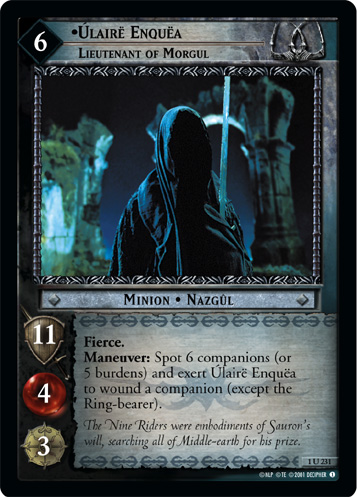 , Gríma, Chief Counselor (5R51)
, Gríma, Chief Counselor (5R51)
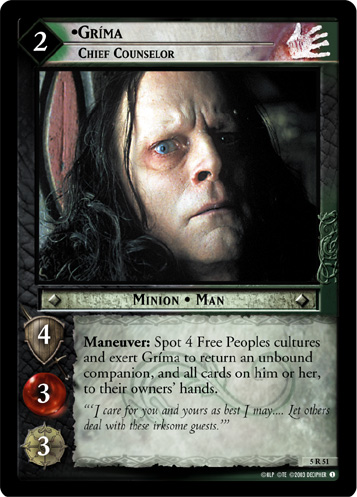 and Gríma, Wormtongue (4R154)
and Gríma, Wormtongue (4R154)
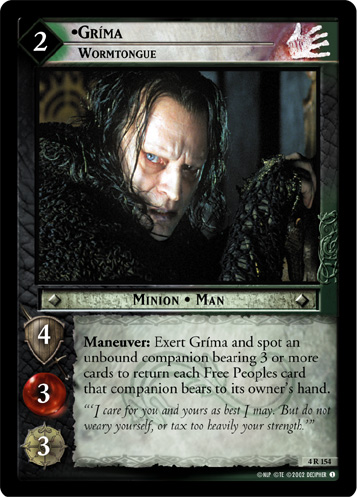 -- cards with no cultural enforcement which almost single-handedly establish some of the game's norms. This lets Gandalf enable larger fellowships, opens up Gandalf, Friend of the Shirefolk (1R72)
-- cards with no cultural enforcement which almost single-handedly establish some of the game's norms. This lets Gandalf enable larger fellowships, opens up Gandalf, Friend of the Shirefolk (1R72)
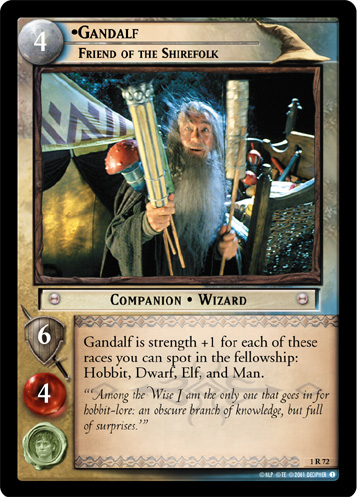 again, and allows card-stacking. Other cards can achieve this, but no other event can do it on its own. This is a blessing and a curse, making it safe from most Shadow player interference at the cost of having one fewer card to cycle through.
again, and allows card-stacking. Other cards can achieve this, but no other event can do it on its own. This is a blessing and a curse, making it safe from most Shadow player interference at the cost of having one fewer card to cycle through.
Playing with a 7-card hand is a constant handicap for both sides of the deck and makes everything come a bit slower. Barliman Butterbur, Prancing Pony Proprietor (1U70)
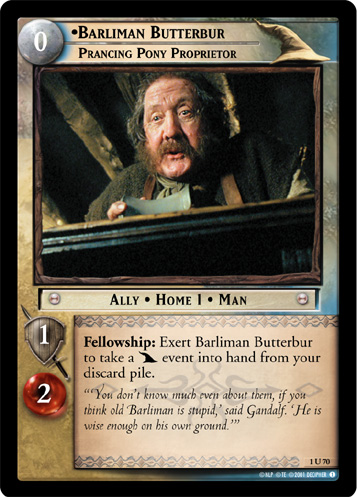 usually allows players to essentially turn the discard pile into an extension of their hands for all
usually allows players to essentially turn the discard pile into an extension of their hands for all Gandalf events, but because there's no indication for when it might be needed there is often little opportunity to benefit from this. Nevertheless, because Enquea and Grima can single-handedly cost the Free Peoples player the game, the protection it offers is well worth the downside. If Barliman isn't needed for anything else and Terrible and Evil is the only Free People card in hand, it is sometimes worthwhile to discard it when reconciling then pull it back into hand in the next Fellowship phase for a one-turn reprieve. When there are more copies of Barliman or Terrible and Evil in the deck that might be drawn, such a move may save you from dead cards down the road.
Of course, stopping a minion from using maneuver-phase text isn't the only use for wounding. Thanks to Gandalf's high vitality, troublesome minions of all sorts - and especially Nazgul - can be killed outright. Swarms rely on numbers, and reducing that number by one can be the difference between losing the game and clearing the board for a double move. Wounding decks can directly benefit from Gandalf and more neatly adopt the rest of his toolkit as a result. Even on its own, its flexibility makes it a natural fit in almost any deck with Gandalf regardless of the danger any specific minion poses.
Deckbuilding Strategy[edit]
If neutralizing a certain minion is the reason for including Terrible and Evil, getting to it can seem to be a top priority. But since those minions often punish strategies for going over a certain threshold, remember that it isn't needed until you cross it. Further, since they tend to be splashes, you are unlikely to need it more than once. Multicultural decks afraid of Gríma, Chief Counselor (5R51)
 are easier to set up and will need it sooner than decks that just need to ward off Gríma, Wormtongue (4R154)
are easier to set up and will need it sooner than decks that just need to ward off Gríma, Wormtongue (4R154)
 or Úlairë Enquëa, Lieutenant of Morgul (1U231)
or Úlairë Enquëa, Lieutenant of Morgul (1U231)
 .
.
A deck which relies on Terrible and Evil alone to cover its Free Peoples must be prepared to play the game with one card fewer for the rest of the deck -- not only will Shadow hands be one card fewer, but the Free Peoples side of the deck will get to everything slower. Certain Shadow sides will be mostly incompatible as a result, especially swarms where every card counts. For the Free Peoples, it will be hard to dig for the cards which set up a combo or fill out a support area. Having plenty of cycling or getting the deck down as close to the 60 card minimum as possible goes far to mitigate the damage this causes.
Otherwise, it should be treated the same as any other utility card. Like Sleep, Caradhras (1C84)
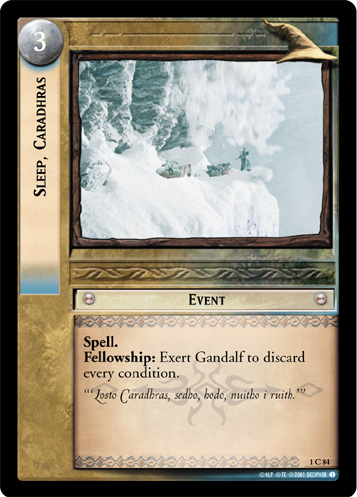 and Roll of Thunder (4U99)
and Roll of Thunder (4U99)
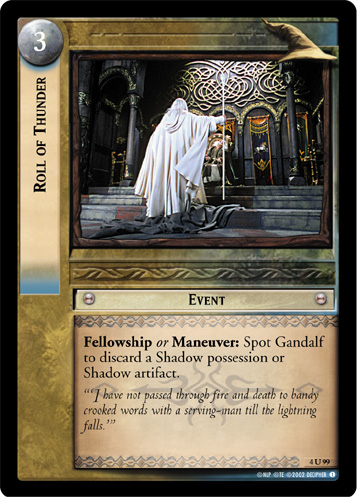 , it is often wise to discard the card if it can't be meaningfully used the turn it is drawn and take it back later with Barliman Butterbur, Prancing Pony Proprietor (1U70)
, it is often wise to discard the card if it can't be meaningfully used the turn it is drawn and take it back later with Barliman Butterbur, Prancing Pony Proprietor (1U70)
 . Gandalf's vitality is a very limited resource, which in turn limits how much this card can be used in a game -- unless an opponent has many minions with 1 vitality and no wound prevention, playing it more than twice requires significant dedication to doing so.
. Gandalf's vitality is a very limited resource, which in turn limits how much this card can be used in a game -- unless an opponent has many minions with 1 vitality and no wound prevention, playing it more than twice requires significant dedication to doing so.
Terrible and Evil is among the best counters to minions with maneuver phase actions, but it is far from the only one:
Dwarven has Slaked Thirsts (7U14)
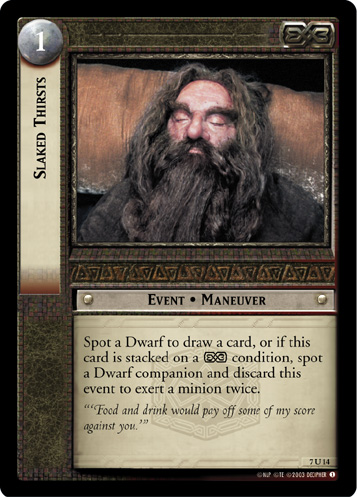 , which with Gimli, Feared Axeman (7R7)
, which with Gimli, Feared Axeman (7R7)
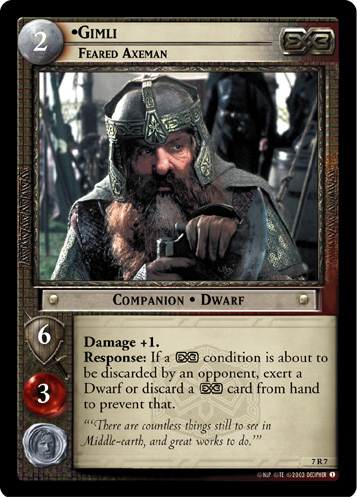 is the safest and most consistent option in the game
is the safest and most consistent option in the gameElven may be able to use Elven Rope (9R13)
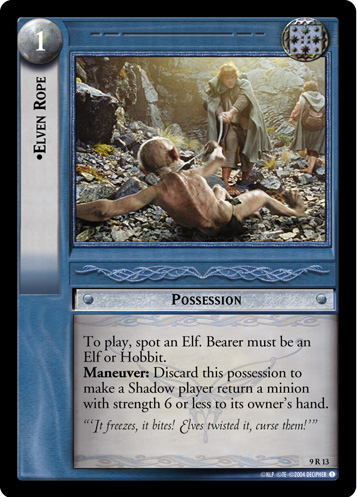 for Grima as long as there are no other weak minions around
for Grima as long as there are no other weak minions aroundRohan benefits greatly from Merry's Sword (7R242)
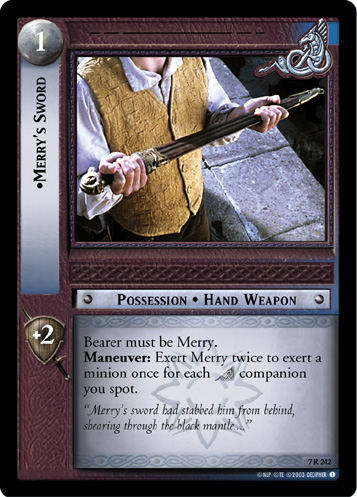 , or on rare occasion Death They Cried (7R223)
, or on rare occasion Death They Cried (7R223)
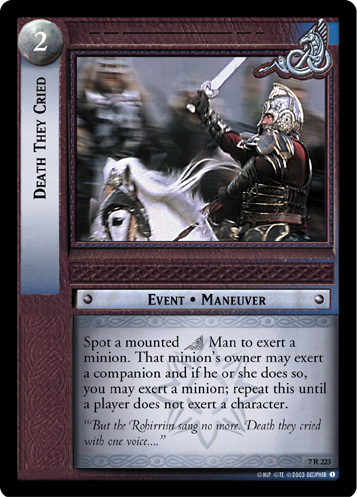
Shire decks can use the Shadowplay (10U114)
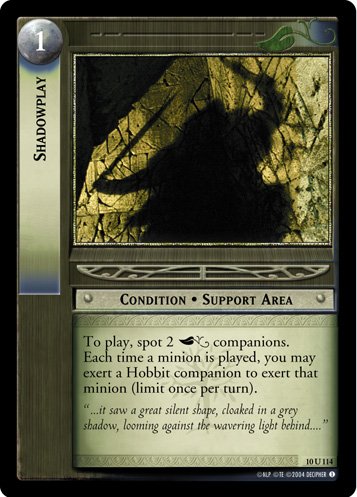 + Unheeded (8R115)
+ Unheeded (8R115)
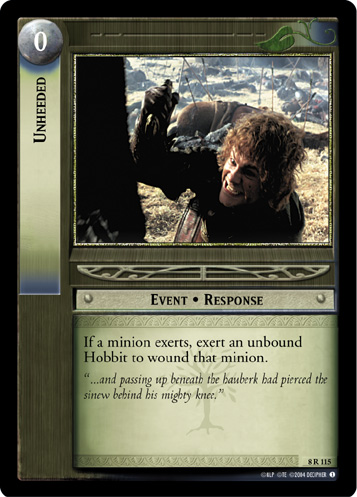 combo
comboGondor has Ithilien Trap (4U126)
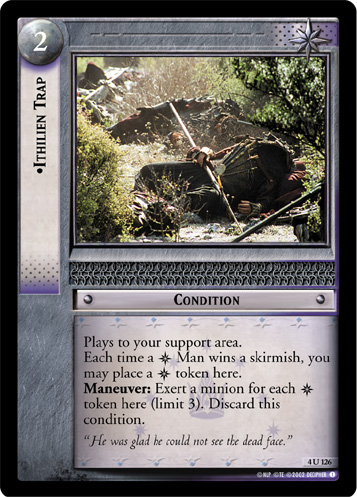 in Movie Block and Denethor, Last Ruling Steward (13R64)
in Movie Block and Denethor, Last Ruling Steward (13R64)
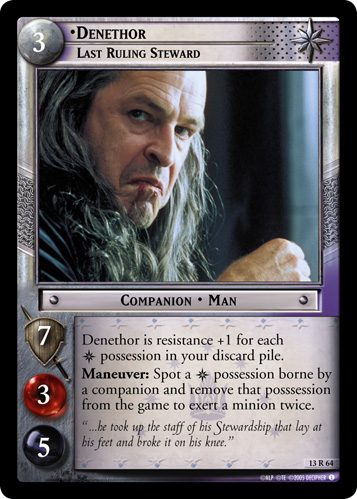 or Madril, Defender of Osgiliath (15R64)
or Madril, Defender of Osgiliath (15R64)
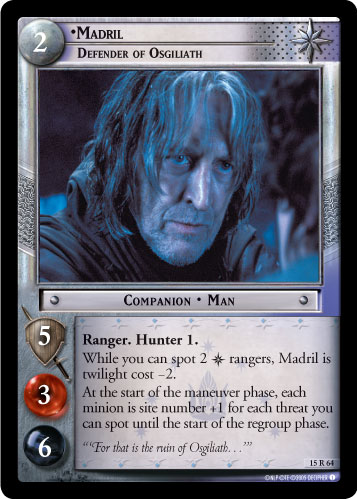 + Ithilien Blade (15C62)
+ Ithilien Blade (15C62)
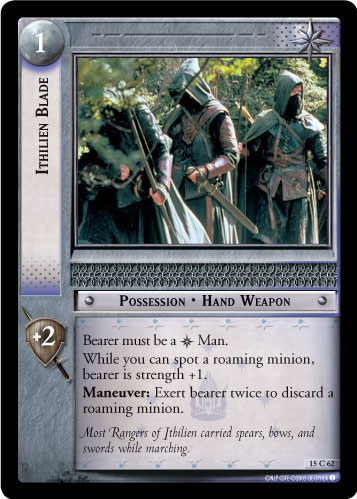 in Expanded
in Expanded
Though not a reliable counter to such minions, Swear by the Precious (15U52)
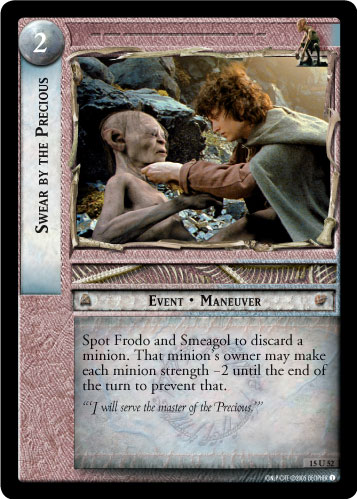 can sometimes force opponents to pick between losing a key minion or losing every skirmish and potentially letting the Free Peoples player double.
can sometimes force opponents to pick between losing a key minion or losing every skirmish and potentially letting the Free Peoples player double.
Strengths and Weaknesses[edit]
Synergizes With...[edit]
- Narya (3R34)
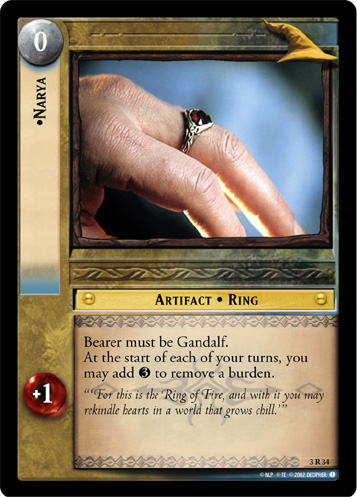 and Gandalf's Staff (2R22)
and Gandalf's Staff (2R22)
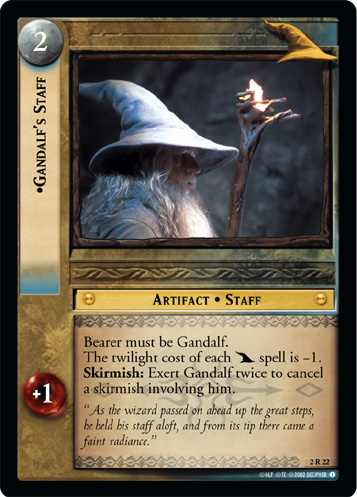 , which add vitality and are difficult to remove
, which add vitality and are difficult to remove - Gandalf, Powerful Guide (15R29)
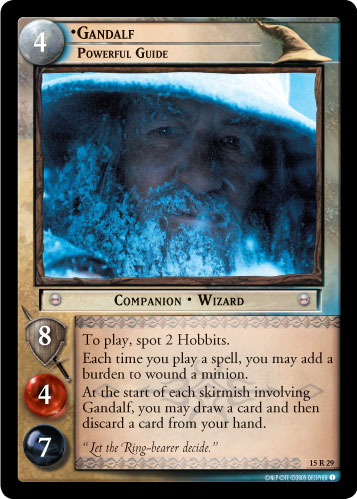 and Radagast's Herb Bag (18R26)
and Radagast's Herb Bag (18R26)
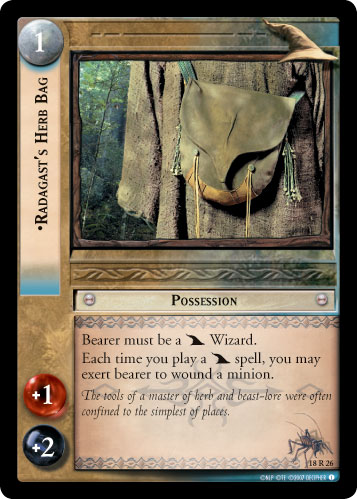
- Gandalf, Friend of the Shirefolk (1R72)
 , which will need some insurance from Gríma, Chief Counselor (5R51)
, which will need some insurance from Gríma, Chief Counselor (5R51)
 and similar effects to get the maximum benefit
and similar effects to get the maximum benefit
Strong Versus...[edit]
- Úlairë Enquëa, Lieutenant of Morgul (1U231)
 , Gríma, Wormtongue (4R154)
, Gríma, Wormtongue (4R154)
 , Orc Patrol (5U107)
, Orc Patrol (5U107)
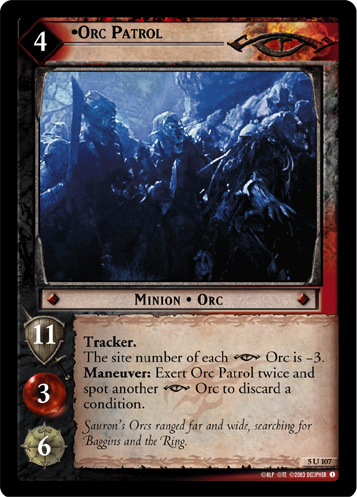 -- any minions which may cause trouble in the maneuver phase
-- any minions which may cause trouble in the maneuver phase - Swarms, especially
Isengard swarms which use Saruman's Snows (1C138)
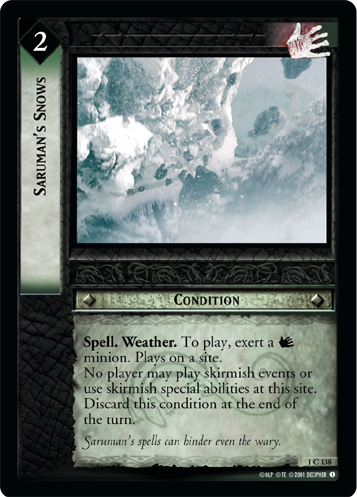 and Isengard Warrior (3U61)
and Isengard Warrior (3U61)
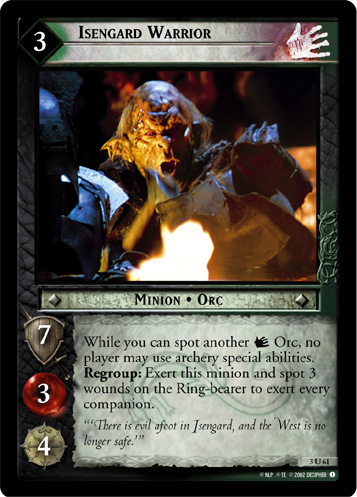 to shut down most other anti-swarm options
to shut down most other anti-swarm options - Certain beatdown decks and especially Nazgul, where a minion can often do more harm alive than the exertions caused by Terrible and Evil to kill it.
- Minions with low vitality and high strength such as Morgul Whelp (7U202)
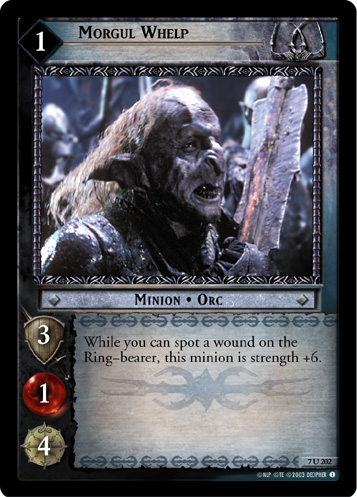
Weak Versus...[edit]
- Wound prevention in general, especially those that remove twilight like Hides (4R19)
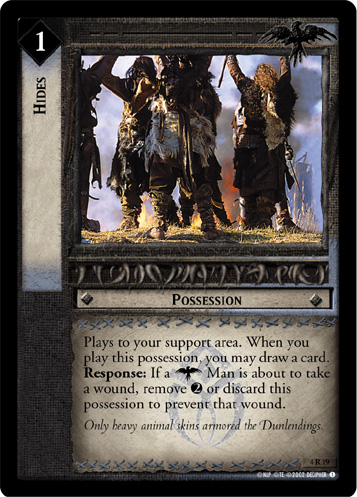 and His Terrible Servants (2R77)
and His Terrible Servants (2R77)
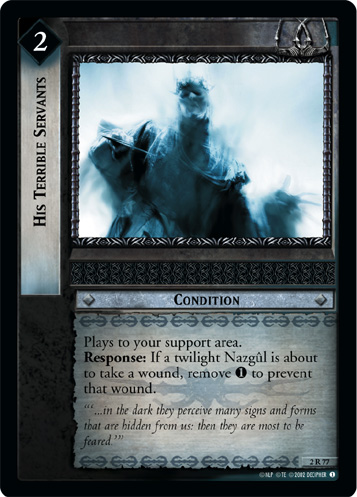
- All Blades Perish (1U203)
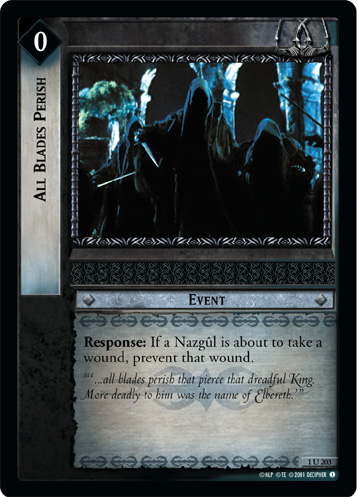 in particular, which can cause the exertions from Terrible and Evil to be fruitless without warning
in particular, which can cause the exertions from Terrible and Evil to be fruitless without warning - High vitality minions such as Gollum and Shelob
- Wounding decks
Rulings[edit]
If the cost of an action requires a character to exert X times, then that character must have X+1 or more vitality or that action cannot be performed. A character cannot exert 0 times to pay the cost of a card that requires a character to exert X times.
- exert section
This means Strength of Spirit (1C85)
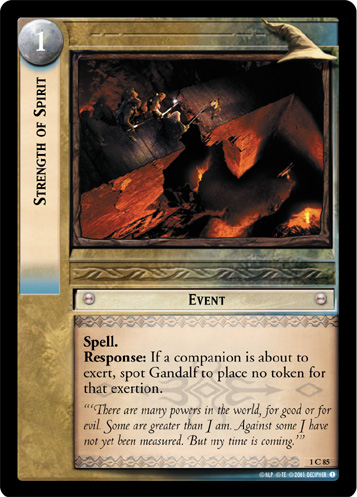 will not allow Gandalf to exert an "extra" time -- it will only prevent one of the exertions from adding a token. Further, the event can't wound a Nazgul once without exerting Gandalf at all.
will not allow Gandalf to exert an "extra" time -- it will only prevent one of the exertions from adding a token. Further, the event can't wound a Nazgul once without exerting Gandalf at all.


